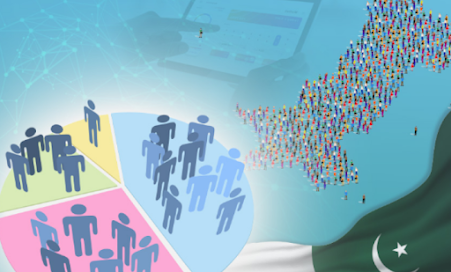Digital Census In Pakistan
Digital Census
Pakistan will start making plans to carry out the first digital census in 2023, marking another step towards the country's digitization.
The 7th Population and Household Digital Census will start on February 1 and will be the first entirely digital census in Pakistani history. NADRA offered a complete IT solution for it. Over 185,000 census blocks in 628 tehsils (In Pakistan, a tehsil is an administrative sub-division of a District) are participating. We'll employ smart devices running the Android operating system that include house listing and enumeration apps connected to GPS and GIS. The Android application allows for simple data syncing and supports both online and offline use. The system for the Pakistan Bureau of Statistics (PBS) will support the pre-census, census, and post-census phases.
The former process involved going to each home and filling out documentation. Salespeople going door to door this year will have tablets or smartphones with digital data input features.
Pakistan's constitution demands that a population census be carried out every 10 years. The results of censuses are used to establish future policies, distribute resources, develop sample plans, define constituencies, and allocate resources. In 1951, 1961, 1972 (which was delayed one year owing to the war in 1971), and 1981, censuses were carried out. Yet the subsequent censuses weren't conducted until 1998 and 2017 because of politicization.
Especially since COVID-19, when there was social isolation and widespread lockdowns, which caused financial services to be digitalized and consumers to go towards e-commerce, there has been rapid digitization. The first digital census was therefore just announced by PBS.
The 2017 census's findings, which were based on a paper-based questionnaire and conventional methods, were contested.
After only a few weeks of preparation, Pakistan is moving forward significantly by converting to a "digital census." Since then, other nations have significantly developed. While Iran and Egypt have successfully performed digital censuses, Turkey has made progress in integrating the combined census technique. In Bangladesh and India, improved census representation of urban areas has also proven very advantageous. Nonetheless, each of these countries underwent extensive training and testing periods.
Iran used 20 devoted workgroups and committees to prepare and organize the 2016 electronic census over two full years. Egypt's 2017 electronic census took two years to plan. Is PBS prepared to move into the digital era, or is it merely doing so for political reasons?
A census requires much planning. A technical committee for the census was constituted in 2021, and it had a record-breaking three months to complete its recommendations. The proposals have already been made public by PBS. A National Census Coordination Center will oversee the actual census. There is currently no action plan outlining all phases of the census, either because nothing has been produced or made public. After the pilot test, a comprehensive dress rehearsal is required if the full census is to be done.
An entirely digital census uses satellite data, aerial photography, a georeferenced address register, and geographic information systems (GIS) for enumeration maps, according to the United Nations Statistical Commission. This equipment is necessary for census mapping. As a result, the automation (e-census/digital census) would need the pre-enumeration phase to use digital maps to determine enumeration districts. If these maps were extensively circulated to the general public and political leadership, everyone's confidence would grow significantly.
While the PBS intends to use a handheld data collection instrument to transfer information obtained during in-person interviews, other steps, such as using GIS facilities for data collection, as well as editing and cleaning information, require a trained staff of experts and a qualified internet network to enable direct transfer of information from the handheld instruments to the central data center. Uncertainty exists over the Support Services Wing of PBS's GIS Wing's capacity to meet UNSC requirements and carry out Pakistan's first-ever digital census duties.
The National Statistical and Spatial Data System is said to be capable of providing a map-digitizing capacity, which will enhance accuracy and the capability to depict enumeration regions utilizing imagery. These maps will allay many worries if they are made available to the general public.
Before the official introduction and usage of the e-census, Iran and Egypt completed two pilot tests. During the 2016 Iranian census, the first pilot test was conducted in 2014 to compare early results and validate the previously available information. In 2015, the requirements underwent additional review, verification, and testing.

The key cause for worry is the anticipated response rate. What may be predicted of Pakistan, a country with a high rate of illiteracy, especially among women? After all, there are already concerns about the 2017 census, which was done using traditional paper interviews. An encouragingly high response rate was reported for the online survey in Iran. In the third iteration, only 68% of respondents from Canada, a country with a high level of education, completed the online portion. The transition to digital and self-enumeration must be gradual, as evidenced by the experience of other countries.
Above all, the general public ought to be properly informed about the initiatives and should have confidence in the system through clear communication.
The census results cannot be continually questioned. The 2017 Census demonstrates that working in two protracted outbursts is ineffective. Enumeration must be done quickly and continuously. Moreover, total openness in data collection and use in the provinces should be ensured. Every area of the census might use technology to increase confidence in the results and lessen skepticism.
A high-level advisory council might be created by incorporating the provinces, several ministries, and institutions. It should function similarly to the one in Egypt, with representatives of civil society and government professionals under the direction of a federal minister. To reduce the chance that the findings would be ignored even before the costly and time-consuming procedure gets started, the 2022 Census Action Plan should be addressed beforehand with lawmakers, major political parties, and the media.
PBS has received the last batch of 126,000 Android tablet devices from NADRA. The question of whether new borders would be drawn in time for the next general elections remains unanswered.
It was challenging to distribute these tablets to the 495 census districts. Yet in just nine days, NADRA finished the exercise that was supposed to support the specialized training of approximately 90,000 enumerators at 932 sites. The 100-person NADRA team put forth a lot of work to swiftly assemble and distribute 126,000 tablet computers. The team successfully ruggedized and hardened the enormous number of tablets at the production site.
The digital census is a move that pulls Pakistan out of its historic past and ushers it into the twenty-first century. Moving from handwritten replies on millions of pages of paper to real-time verified data in apps on secure devices with satellite images is a step towards a digital Pakistan. The digital census' large data will be the basis for Pakistan's method of creating evidence-based policy. In under three weeks, NADRA developed a digital solution for a digital census using modern agile methods.
The entire digital solution includes call center services, technical support centers at each tehsil level, data center services, technical support centers, a public web portal, and other ancillary services. A global positioning system (GPS) and geographic information system are coordinated with the house listings and enumeration applications created and distributed on Android (GIS). The Android app for the digital census offers both online and offline use with seamless data synchronization. The system for PBS will support the pre-census, census stage, and post-census phases of the census.
NADRA is PBS's technology collaborator on the initial digital census program. To make this large national exercise a success, NADRA's involvement in it is to provide IT-related services. The census will be more transparent as a consequence, and by employing technology and digitization, it will ensure that the whole population is registered.
The first digital census process, which has not yet started, would not be officially announced as having reached its conclusion until March 31, 2023, according to a link established by the Election Commission of Pakistan (ECP) on December 16. After evaluating the minimum amount of time required within the timing limits, a decision was taken and relayed to the government. The ECP has previously ruled out any additional delimitation if the official announcement of the census results is made public beyond December 31, 2022.
NADRA completed its job ahead of schedule, but it is unclear if the digital census exercise, which has not yet begun, will be completed by the end of March. The fieldwork would be completed in the first week of March, and data validation would come next. Before being presented to the CCI for approval, data at the block level may need to be vetted for two to three weeks.
For reading more interesting blogs visit: Pinnacle Of Triumph


Comments
Post a Comment